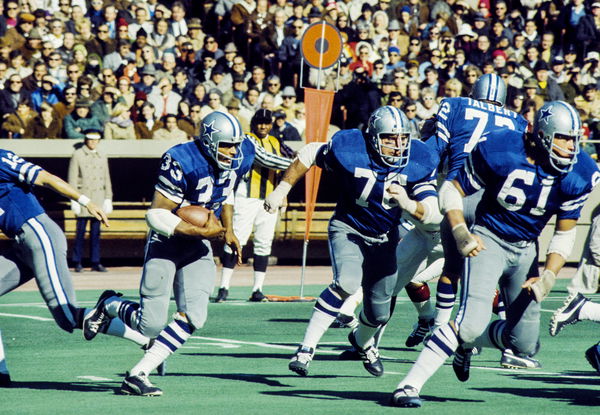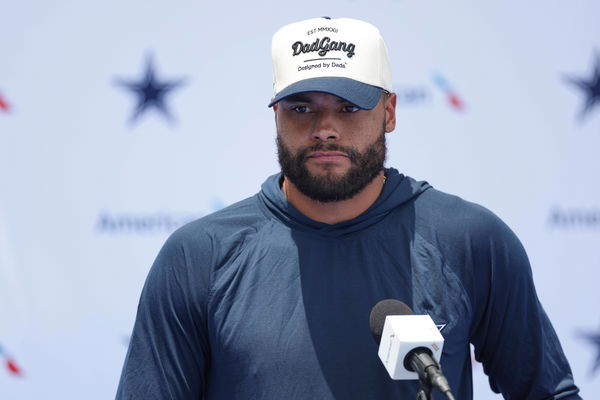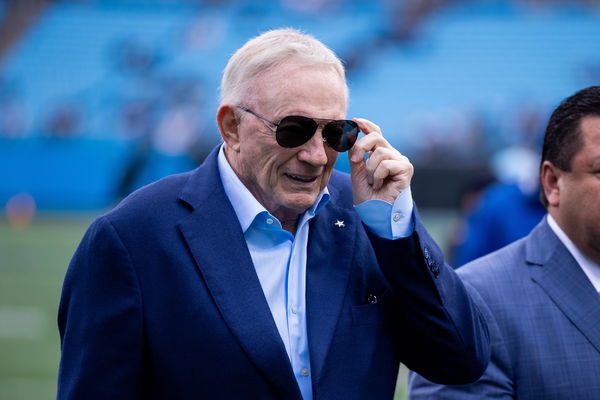
Imago
US PRESSWIRE Sports-Historical Dec 25, 1971 Bloomington, MN, USA FILE PHOTO Dallas Cowboys quarterback Roger Staubach 12 during the 1971 NFC Divisional Playoff Game against the Minnesota Vikings at Metropolitan Stadium. The Cowboys defeated the Vikings 20-12. Bloomington Minnesota UNITED STATES, EDITORIAL USE ONLY PUBLICATIONxINxGERxSUIxAUTxONLY Copyright: xMalcolmxEmmons-USAxTODAYxSportsx 5361702

Imago
US PRESSWIRE Sports-Historical Dec 25, 1971 Bloomington, MN, USA FILE PHOTO Dallas Cowboys quarterback Roger Staubach 12 during the 1971 NFC Divisional Playoff Game against the Minnesota Vikings at Metropolitan Stadium. The Cowboys defeated the Vikings 20-12. Bloomington Minnesota UNITED STATES, EDITORIAL USE ONLY PUBLICATIONxINxGERxSUIxAUTxONLY Copyright: xMalcolmxEmmons-USAxTODAYxSportsx 5361702
Watch the film from Super Bowl VI next to the Cowboys’ latest tape, and it’s night and day. Back in ’71, Dallas shut down Miami 24–3, holding them to just 185 total yards and a lonely field goal. That team was built on three rock-solid pillars: An elite O-line, a defense with real field generals, and a quarterback who came through when it mattered most. Those pillars didn’t just win games; they made Dallas the standard.
Watch What’s Trending Now!
Today’s Cowboys have big-name stars, one of the most loyal fan bases in world sports, and a multi-billion-dollar franchise. What’s missing? The DNA that powered the ’71 champs. The trenches aren’t dominating week in and week out, linebacker leadership feels more patchwork than commanding, and the kind of structure that turns regular-season flashes into playoff wins just isn’t always there. So where did it all go wrong?
ADVERTISEMENT
The Doomsday defense standard
Tom Landry’s Doomsday Defense was elegant, disciplined, and downright deadly. In Super Bowl VI, they smothered Miami, a reminder to the whole league that defense could win the biggest games. That roster had nine future Hall of Famers, which meant rare depth and football IQ everywhere you looked.
The linebacker trio of Chuck Howley, Lee Roy Jordan, and Dave Edwards snagged nine interceptions in 1971. Everything seemed structured; Indeed, that ‘polish’ was never missing. It was so well-oiled that it just couldn’t put a foot wrong. That defense didn’t just shut teams down; it forced them to scrap their game plans entirely. And as good as that defense was, the QB protection was just as good.
ADVERTISEMENT
Offensive line dominance
Championship football usually gets settled in the trenches, and the ’71 Cowboys’ O-line was a master class in how to win there. With Hall of Famer Rayfield Wright leading the way and Pro Bowlers John Niland and Ralph Neely beside him, that group opened lanes, kept the quarterback clean, and flat-out wore teams down. They helped crank out 25 rushing touchdowns that year and made play-action a weapon you could trust all game long.

USA Today via Reuters
NFL, American Football Herren, USA USA TODAY Sports-Archive Nov 7, 1971 St. Louis, MO, USA FILE PHOTO Dallas Cowboys offensive guards Blaine Nye 61 and John Niland 76 block for running back Duane Thomas 33 as he carries the ball against the St. Louis Cardinals at Busch Stadium. Mandatory Credit Herb Weitman-USA TODAY Sports St. Louis Missouri UNITED STATES, EDITORIAL USE ONLY PUBLICATIONxINxGERxSUIxAUTxONLY Copyright: xHerbxWeitmanx 8390671
When your line owns the line of scrimmage, it changes everything. It changes how you control the clock, how fast you play, and how defenses are forced to line up against you. And the man this O-line was protecting? Absolute madman.
ADVERTISEMENT
The Staubach factor
Roger Staubach was the man who turned good teams into champions. In ’71, he put up 1,882 passing yards, 15 touchdowns with just 4 picks, plus 343 rushing yards and a couple more scores on the ground. But these numbers don’t underscore how influential he really was. Once he became the full-time starter, the Cowboys rattled off 10 straight wins. And those wins? Driven by him, almost entirely. He came alive when there was late-game pressure. He almost made the comebacks feel inevitable. That’s what great quarterbacks do, and Staubach was the blueprint. The original Captain Comeback.
ADVERTISEMENT
You know know you could just feel a comeback coming when you saw Dallas back in the 70s? You don’t feel the warmth of that blanket of security even when you’re leading now. Let’s talk about how we came to this.
Offensive line decline
The O-line was arguably the most pivotal pillar of Dallas. It might’ve become its biggest weakness. The numbers would tell you. 25 rushing touchdowns in ’71 compared to just 6 in 2024. That’s not just a stat, that’s an identity crisis. Sure, there’s young talent up front. Tyler Smith’s a beast, Cooper Beebe’s got promise, and Tyler Guyton showed flashes as a rookie. But it might never become the well-oiled, steamrolling machine that the ’71 line was.
ADVERTISEMENT
Linebacker leadership void
Back in ’71, the Cowboys had Lee Roy Jordan, a linebacker who was the quarterback of the defense, calling every shot and setting the tone.
Yes, Micah Parsons is a once-in-a-generation game-wrecker, but terrorizing off the edge isn’t the same as running the huddle from the middle of the field. Without that Lee Roy Jordan–type presence, you get a defense that can wreck plays but can’t string together 60 minutes of airtight football.
ADVERTISEMENT
The concern is, since Roger Staubach, no Cowboys quarterback has combined regular-season dominance with consistent late-game heroics on the championship stage.
Quarterback consistency questions
Dak Prescott may never become that legendary quarterback. He’s got the ability, sure. No one’s questioning that. In 2023, he racked up 4,516 yards and 36 touchdowns. That’s MVP-level production. But here’s the thing: the great ones earn their legacy in January. That’s where Staubach built his legend, and that’s where Dak still has something to prove.
ADVERTISEMENT

Imago
OXNARD, CA – JULY 25: Dallas Cowboys quarterback Dak Prescott 4 speaks with reporters during the team s training camp at River Ridge Playing Fields on July 25, 2024 in Oxnard, CA. Photo by Brandon Sloter/Icon Sportswire NFL, American Football Herren, USA JUL 25 Cowboys Training Camp EDITORIAL USE ONLY Icon240725059
He needs to take that regular-season firepower and make it show up when the lights are brightest. He has failed to do that so far. And that failure is on the Cowboys, too. They need to do their part. Give him stronger protection, a running game defenses actually respect, and a defense that hands him short fields with takeaways when everything’s on the line. They haven’t done that so far. That’s only one of the many, many things this team needs to change.
ADVERTISEMENT
The Championship Prescription
If a championship DNA can be lost, it can be rebuilt, too. And the Cowboys have the tools to do it. You know what the priority is: rebuilding the trenches. Get guys who can handle both power and zone looks, and who don’t just block, but finish those blocks. When the line’s dominant, third downs feel easy, the offense can dictate the pace, and you’re not riding a roller coaster come playoff time.
You don’t structure a rebuild by not fixing what made you fall. And that fix lies in locking down a true defensive voice at linebacker. Spend an early draft pick or bring in the right vet in free agency. All these teams need is someone who can read the offense, make the calls, and be the rock in the middle against the run. Then surround that guy with fast, athletic backers who can chase, tackle, and force turnovers. Get that combo right, and the whole defense levels up.
Not just at linebacker, this team needs a leader at every single position. Three guys from the ’71 Cowboys went on to NFL head coaching careers that included at least one Super Bowl. Mike Ditka led the ’85 Bears, and Dan Reeves, who guided the Broncos to the Super Bowl in ’86, ’87, and ’89, and later took the Falcons there in ’98. These were the personalities in the 71′ locker room.

Imago
NFL, American Football Herren, USA 2024: Cowboys at Panthers Dec 15 December 15, 2024: Dallas Cowboys owner Jerry Jones before the NFL matchup in Charlotte, NC. Scott Kinser/CSM Credit Image: Scott Kinser/Cal Media Charlotte Nc United States EDITORIAL USE ONLY Copyright: xx ZUMA-20241215_zma_c04_111.jpg ScottxKinserx csmphotothree333356
Let’s be honest, they can’t replicate the doomsday mentality, but they can modernize it. Build a scheme that locks down gap integrity and hunts for takeaways, all while letting Micah Parsons unleash the chaos he’s built for. And up front? Make sure the interior can finish the job so pressures turn into turnovers and short fields. Turning the defense into an extension of the offense sounds like football 101. But the Cowboys have consistently failed to do that.
The playoff pressure is where this team crumbles. They can have all the ability in the world, but there’s no upside to that if they crack in January.
The 71′ soaked up that pressure. The Cowboys had made the playoffs five years running, starting in 1966, but a championship kept slipping through their fingers. They fell to Green Bay in the NFL title game in both ’66 and ’67. And after back-to-back playoff defeats to Cleveland in ’68 and ’69, Dallas came up just short in Super Bowl V in Miami, when rookie kicker Jim O’Brien of the Colts nailed a last-second field goal. It was now or never in 1971. And they stepped up. The current Dallas roster has never stepped up when it mattered.
Brian Schottenheimer needs to make every practice feel like the playoffs. Run those two-minute drills, red-zone battles, and gotta-have-it third downs like it’s Sunday with the season on the line. And Dak Prescott needs to be in the thick of it. Sharpen up Dak’s situational training. Put him through those late-game pressure reps again and again, and set up the offense so he’s facing manageable third downs with solid protection. Dak has all the natural ability in the world; make it count.
These fixes aren’t impossible. Certainly not for the richest franchise in the world. But they are architectural, not magical. Jerry Jones needs to instil a sense of urgency. The implementation can take up to a decade, or it can take two years. That’s entirely contingent upon how Jerry pictures the future is this team. Does he want to build a media empire, or does he want the team of his life to return to its glory days?
ADVERTISEMENT
ADVERTISEMENT
ADVERTISEMENT

